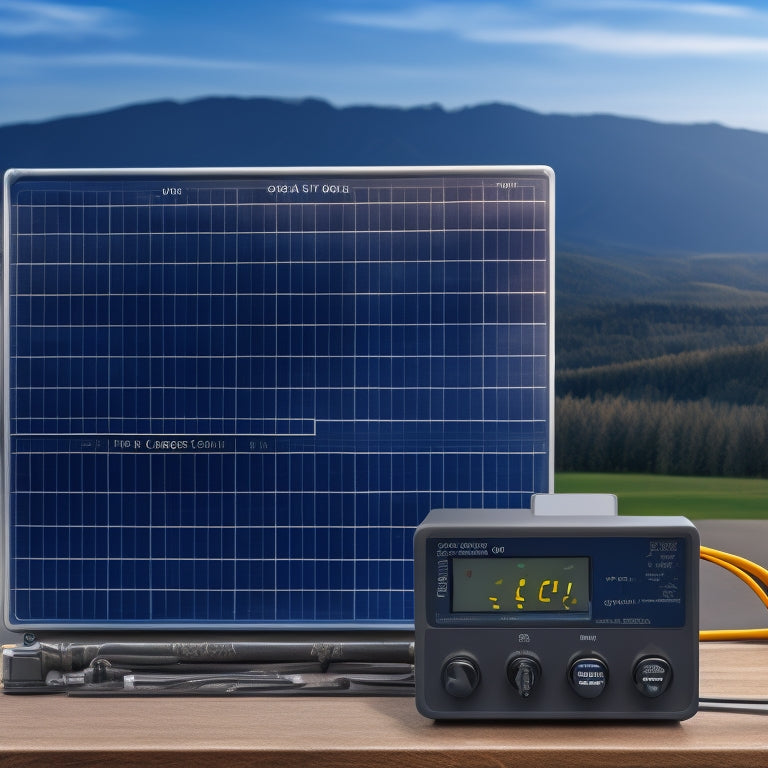
Optimal Battery Charge Controller Settings Explained
Share
When setting up your battery charge controller, you need to get it just right to maximize energy storage efficiency and lifespan. You'll want to refine your float charge voltage, which depends on your battery type, with flooded batteries requiring 2.25-2.30V per cell and sealed batteries needing 2.30-2.35V per cell. You'll also need to configure bulk charge mode, absorption charge time, and equalization charge cycles to balance charging and discharging. Overcharge protection settings and temperature compensation are essential to prevent damage. By fine-tuning these settings and monitoring performance, you'll be able to release your energy storage system's full potential - and that's just the starting point for achieving ideal results.
Overview
- Optimal float charge voltage settings, typically between 2.25-2.35V per cell, extend battery lifespan and vary by battery chemistry.
- Bulk charge mode rapidly replenishes the battery state of charge in 1-4 hours, prioritizing current over voltage regulation.
- Absorption charge time balancing ensures complete charging without unnecessary wear, with recommended voltage thresholds between 14.4-14.7 volts.
- Correct voltage thresholds, temperature compensation, and equalization charge cycles are crucial for maintaining a healthy battery state of charge.
- Overcharge protection settings, including voltage thresholds and temperature limits, prevent reduced lifespan, heat, and fire hazards.
Understanding Charge Controller Basics
When considering a charge controller, it's vital to step back and examine the underlying principles that govern its operation. You need to understand how it manages the flow of energy between your solar panels, battery, and load.
A good charge controller should have features that prioritize battery health, such as overcharge protection, temperature compensation, and low-voltage disconnect. These features guarantee your battery operates within a safe voltage range, preventing damage and prolonging its lifespan.
For instance, selecting a battery with high-depth-of-discharge capabilities like the Tesla Powerwall can provide greater flexibility in your energy system. Similarly, evaluating battery chemistry, such as lead-acid vs. lithium-ion, is essential for compatibility.
Setting Optimal Float Charge Voltages
When setting ideal float charge voltages, you'll need to take into account the specific voltage ranges recommended for your battery type, as well as variations between flooded, AGM, and gel batteries.
Additionally, you'll need to factor in voltage drop considerations, such as cable length and resistance, to guarantee the correct voltage reaches your batteries.
It's also essential to maintain perfect operating temperatures, as high temperatures (>35°C or 95°F) can accelerate degradation operating temperature ranges, and regular maintenance checks can help identify issues before they escalate.
Float ChargeVoltage Ranges
Configuring the ideal float charge voltage range is vital to prolonging your battery's lifespan and guaranteeing its overall health.
When you're setting the float charge voltage, you're aiming for a stable voltage that won't overcharge or undercharge your battery. A common range for flooded batteries is 2.25-2.30V per cell, while sealed batteries typically require 2.30-2.35V per cell.
To ascertain accurate battery sizing, it's essential to calculate daily energy usage and consider factors like deep cycling and warranty length. You'll need to consult your battery manufacturer's specifications to determine the best range for your specific battery.
Battery Type Variations
Different battery types demand distinct float charge voltage settings to ascertain peak performance and longevity.
You'll need to adjust the float charge voltage based on the specific battery type you're using. For instance, lithium batteries require a lower float charge voltage to prevent overcharging, which can reduce their lifespan.
Lead acid, AGM, and gel batteries, on the other hand, can handle higher float charge voltages. Nickel cadmium batteries, being more forgiving, can operate within a wider range of float charge voltages.
Temperature effects also play a role, as high temperatures can increase charge efficiency but reduce battery lifespan.
Voltage Drop Considerations
As you maneuver through the complexities of ideal battery charge controller settings, voltage drop factors emerge as a critical aspect in setting ideal float charge voltages.
You must account for voltage drop to guarantee your batteries receive the correct charge. A higher voltage drop results in a lower charge voltage, which can lead to undercharging and reduced battery lifespan.
To mitigate this, you'll need to take into account the wire gauge and length between your charge controller and batteries. A larger wire gauge will reduce voltage drop, but it's crucial to find a balance between wire size and cost.
Bulk Charge Mode Explained
During the bulk charge mode, your charge controller takes center stage, rapidly replenishing your battery's state of charge. This mode offers several bulk charge benefits, including a shorter bulk charge duration, typically lasting between 1-4 hours depending on your system's configuration.
| Charge Controller Setting | Bulk Charge Mode | Description |
|---|---|---|
| Current Limit | High | Allows for rapid charging |
| Voltage Regulation | Disabled | Prioritizes current over voltage |
| Charge Cycles | Unlimited | Continuous charging until SOC reaches 80% |
| Monitoring | Disabled | Reduces system overhead |
| Termination Point | 80% SOC | Prevents overcharging |
Absorption Charge Time Settings
You'll need to carefully adjust the absorption charge time settings to guarantee your battery is fully charged and maintained.
This involves setting the charge cycle timing to match your battery's specific requirements, as well as defining the voltage threshold limits that trigger the changeover from bulk to absorption mode.
Charge Cycle Timing
Your battery's absorption charge time setting determines the duration the charge controller spends topping off your batteries after a bulk charge, guaranteeing they're fully prepared for the next discharge cycle.
This setting directly impacts your charge cycle frequency and duration. When you set the absorption charge time too short, your batteries may not be fully charged, leading to reduced overall capacity.
On the other hand, setting it too long can cause unnecessary wear on your batteries. You need to find the sweet spot that balances charge cycle frequency and duration.
A well-adjusted absorption charge time setting secures your batteries are fully charged and ready for the next discharge cycle, giving you the freedom to enjoy your off-grid escapades without worrying about your power supply.
Voltage Threshold Limits
To maximize your battery's absorption charge time, you've got to set the right voltage threshold limits. This involves making precise threshold adjustments to guarantee your battery is fully charged without being overcharged.
The key is to find the sweet spot where your battery is fully saturated, but not so high that it reduces its lifespan. For most deep-cycle batteries, the recommended absorption voltage threshold is between 14.4 and 14.7 volts.
However, this may vary depending on the specific battery type and manufacturer's recommendations. By fine-tuning your voltage regulation, you can achieve ideal absorption charge times, confirming your battery is ready to provide reliable power when you need it.
Equalization Charge Cycle Control
As the battery management system's (BMS) most critical function, equalization charge cycle control guarantees that each cell within a battery pack is maintained at a consistent state of charge, preventing premature degradation and extending overall lifespan.
You'll need to set the equalization frequency, which determines how often the BMS performs equalization. A higher frequency assures cells stay balanced, but increases energy consumption.
You'll also need to set the equalization duration, which affects how long the BMS takes to balance the cells. A longer duration is more effective, but may reduce overall system efficiency.
Overcharge Protection Settings
Having guaranteed each cell within the battery pack is maintained at a consistent state of charge through equalization charge cycle control, you can now focus on preventing overcharging, which can cause irreversible damage to the cells. Overcharge risks include reduced battery lifespan, increased heat generation, and even fire hazards. To mitigate these risks, you need to set ideal overcharge protection settings.
| Overcharge Symptoms | Setting | Threshold |
|---|---|---|
| Cell voltage | Overcharge detection voltage | 3.45V |
| Charge time | Overcharge detection time | 1 hour |
| Temperature | Overcharge detection temperature | 45°C |
Monitoring Charge Controller Performance
You've set your overcharge protection settings, now it's crucial to monitor your charge controller's performance to verify these settings are effective and your battery is operating within a safe zone.
To do this, you'll need to track key performance metrics such as controller efficiency, voltage, and current output. Data logging capabilities can help you analyze this data and identify areas for improvement.
A user-friendly interface is fundamental for real-time monitoring and troubleshooting. Look for a charge controller with system integration capabilities to seamlessly connect with your existing setup.
By establishing performance benchmarks, you can optimize your charge controller's settings and confirm your battery is performing at its best.
With these tools, you'll be equipped to make data-driven decisions and maximize your energy freedom.
Frequently Asked Questions
Can I Mix Old and New Batteries in My Solar Power System?
You shouldn't mix old and new batteries, as it'll reduce overall battery lifespan and charging efficiency. The new batteries will be dragged down by the older ones, causing uneven charging and discharging, which can lead to premature wear and tear.
How Often Should I Clean My Charge Controller's Heat Sink?
Did you know 85% of charge controller failures occur due to overheating? You should clean your charge controller's heat sink every 3-6 months to maintain ideal heat sink maintenance, ensuring controller efficiency and prolonging its lifespan for a reliable off-grid energy system.
Are Charge Controllers Compatible With All Types of Batteries?
You'll find that charge controllers aren't universally compatible with all battery types, as compatibility issues arise from differing charging profiles and maintenance requirements, so it's essential to match your controller with a battery that shares its charging characteristics.
Can I Use a Charge Controller With a Wind Turbine System?
You can use a charge controller with a wind turbine system if it's designed for wind turbine compatibility, featuring maximum power point tracking and overcharge protection to guarantee efficient energy harvesting and safeguard your battery's health.
Do I Need a Charge Controller for a Small Solar Panel System?
You might think a small solar panel system doesn't need a charge controller, but you're wrong; it's essential to maximize solar panel efficiency and prevent battery damage - a charge controller's benefits will give you the freedom to utilize renewable energy efficiently.
Ready to Buy
As you fine-tune your charge controller, imagine an orchestra of electrons harmoniously flowing into your battery, each note precision-crafted to maximize efficiency and lifespan. With ideal settings, your system hums like a well-oiled machine, safeguarding your investment and ensuring a bright, sustainable future. Now, your charge controller is no longer a mystery, but a trusted ally in your quest for energy independence.
Related Posts
-

Net Metering in Renewable Energy's Future
Net metering's future is vital for driving renewable energy growth and financial savings. You can reduce your electri...
-

What Types of Solar Energy Devices Are Available
You'll find several types of solar energy devices available today, each customized to different energy needs. Photovo...
-

Solar Phone Chargers for Camping Essentials
Solar phone chargers are must-haves for your camping essentials, allowing you to stay connected while enjoying nature...


